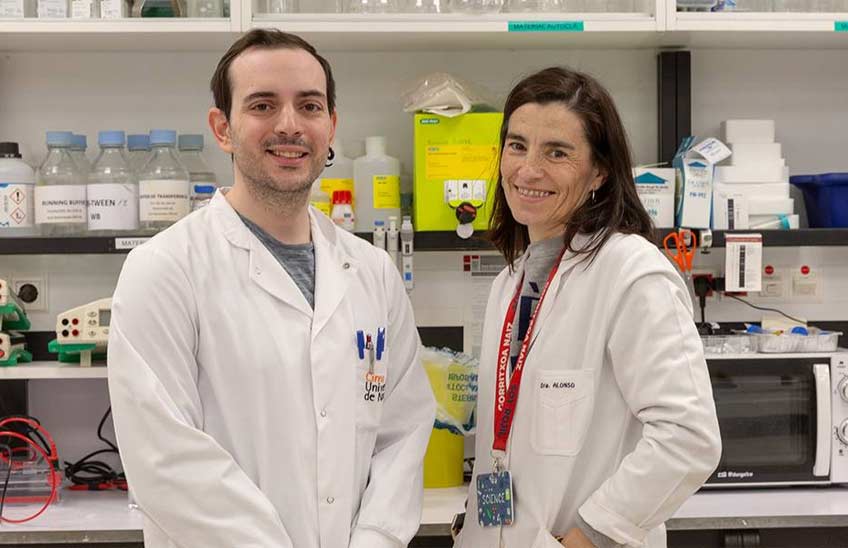20240326_CIE_bloqueo_proteina
Blockade of a clotting protein during stroke process reduces brain damage in experimental models
Researchers at Cima University of Navarra confirm for the first time that FXIII increases clot density and resistance to current treatments in thrombi in stroke patients.

FotoManuelCastells
/Lara Montori, Juan Marta, José Antonio Rodríguez, Josune Orbe, Florencio Machado and Miriam Belzunce, Cima team that participated in the project.
26 | 03 | 2024
Researchers at Cima University of Navarra have shown that blocking a clotting protein during the process of stroke development reduces brain damage in experimental models.
Stroke is the second leading cause of death in our environment (first in women) as well as the leading cause of acquired disability in adults. The costs derived from stroke account for around 3-4% of the total health care expense in our country, in addition to a significant social burden staff and family, with great impact on the person who suffers it and their caregivers. Ischemic stroke is the most common (85%) and is mainly caused when a thrombus obstructs the cerebral arteries, preventing proper blood flow. The treatment of stroke consists of the administration of a thrombolytic, tPA, which acts by undoing the thrombus to save part of the brain tissue at risk of dying. However, it should be administered in the first hours after the stroke, its efficacy is poor in the case of large vessel occlusions and it is contraindicated in patients with a higher risk of developing hemorrhagic complications.
It is known that coagulation factor XIII participates in the training of thrombi that produce ischemic stroke. In addition, it has been shown to be involved in other processes of tissue remodeling and protein binding that could be involved in resistance to current stroke treatments. "The novelty of our work is that we have managed to administer for the first time a molecule capable of blocking FXIII while stroke is occurring in experimental models," says Dr. Juan Marta, first author of work.
Moreover, as indicated by Dr. Josune Orbe, researcher at Cima University of Navarra and director of work, "we have shown that it reduces brain damage and improves the functional state of the mice". The conclusions have been published in the scientific journal Journal of Thrombosis and Haemostasis.
Combination with current treatment
The work confirms that the presence of factor XIII is associated with increased clot stiffness, increased density of fibrin fibers (a major protein of blood clots) and increased binding of alpha2-antiplasmin protein, leading to resistance to lysis or "dissolution" of the thrombus. "In this line, thrombus lysis experiments obtained from stroke patients show us a greater potency of treatment with t-PA when combined with the FXIII inhibitor molecule, which increases thrombus lysis," says the researcher at Cima. This study opens up a new avenue for the treatment of ischemic stroke by combining an FXIII inhibitor with the usual treatment in order to enhance its effect. As Dr. Orbe points out, "these are preclinical results, so further studies are needed programs of study before clinical trials can be considered".
This study has been carried out thanks to the partnership of patients who have donated their samples to the biobanks of the University of Navarra and the Aragon Health System. It has been carried out in the framework of the Networks of research Cooperative oriented to Health Outcomes (RICORS)-Ictus and the CIBER Cardiovascular (CIBERCV), with the partnership of the Clínica Universidad de NavarraHospital Universitario de Navarra, Hospital Universitario Vall d'Hebron and Hospital Universitario Miguel Servet.





